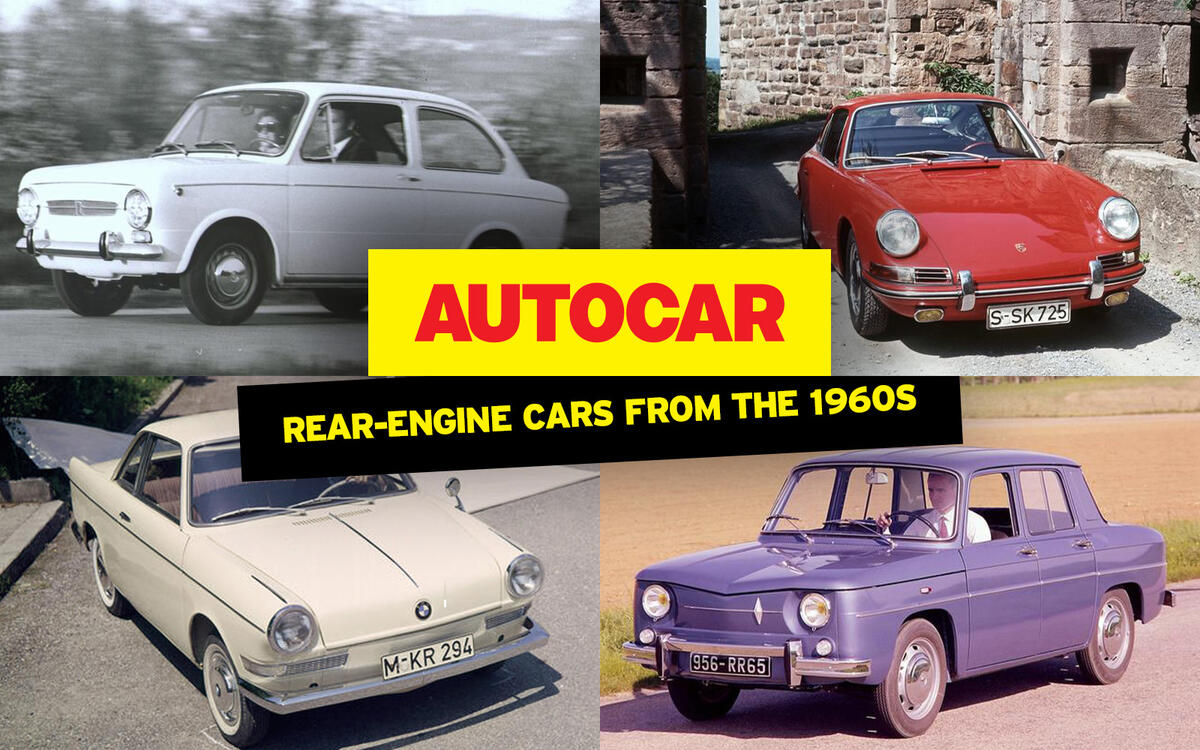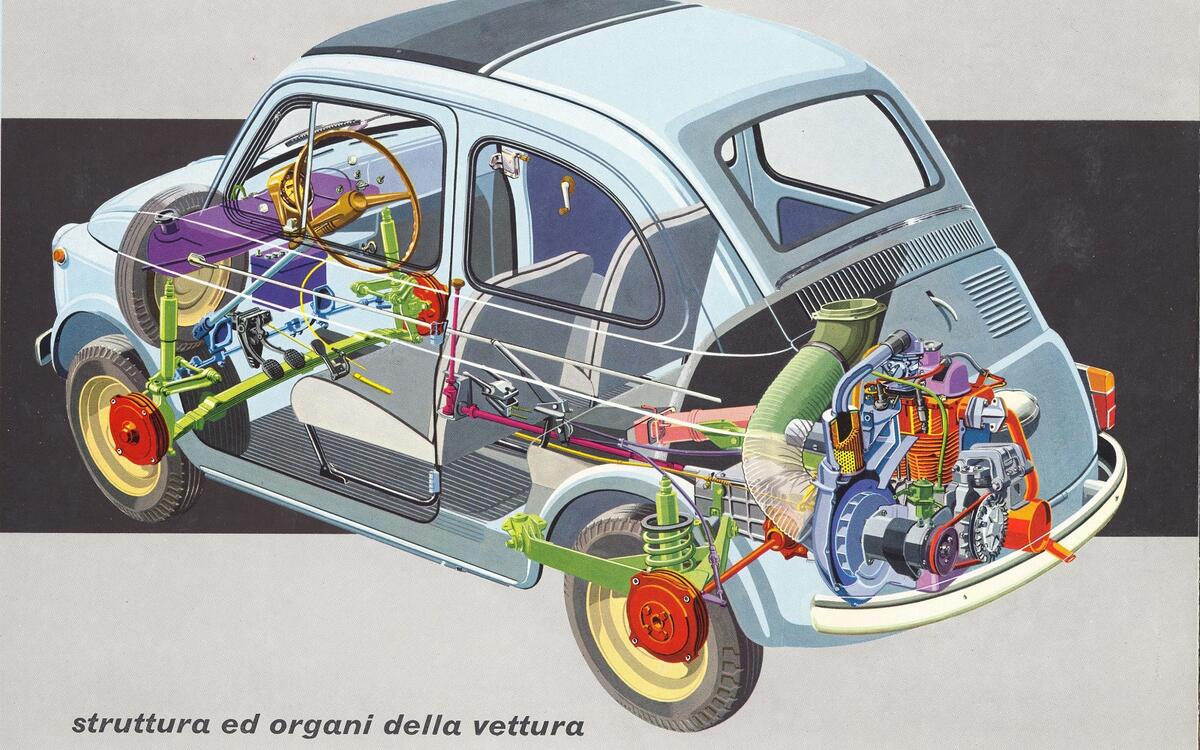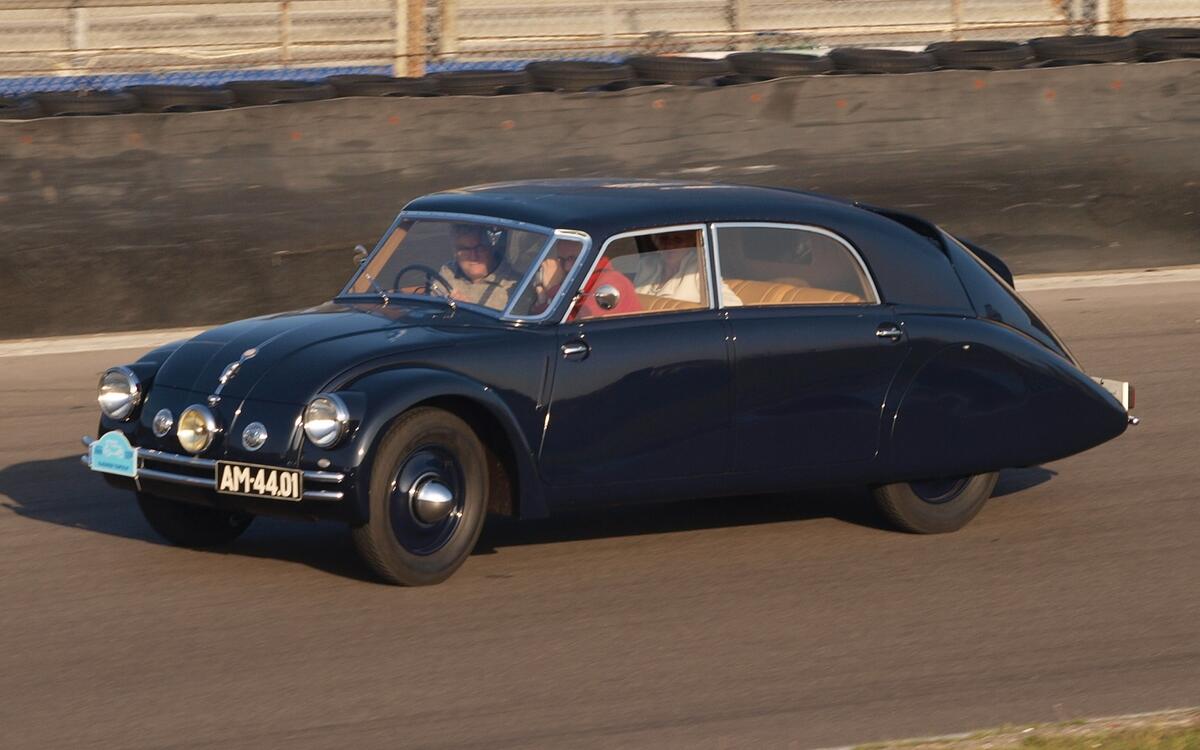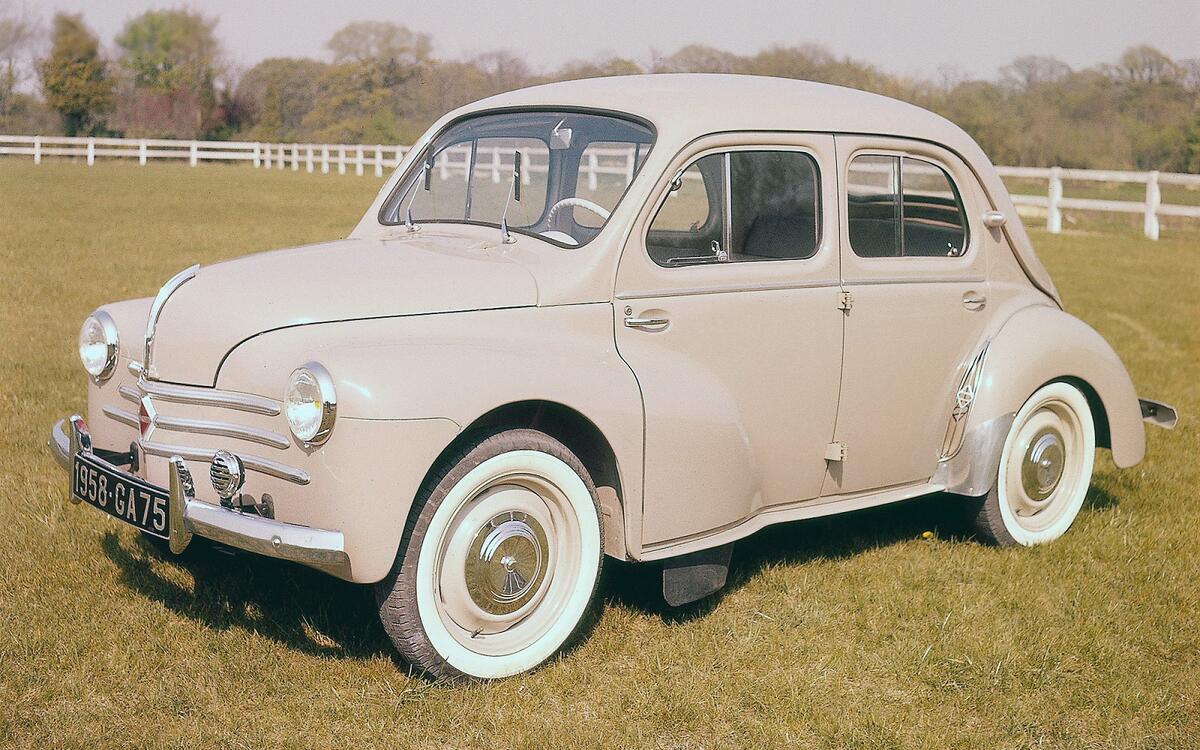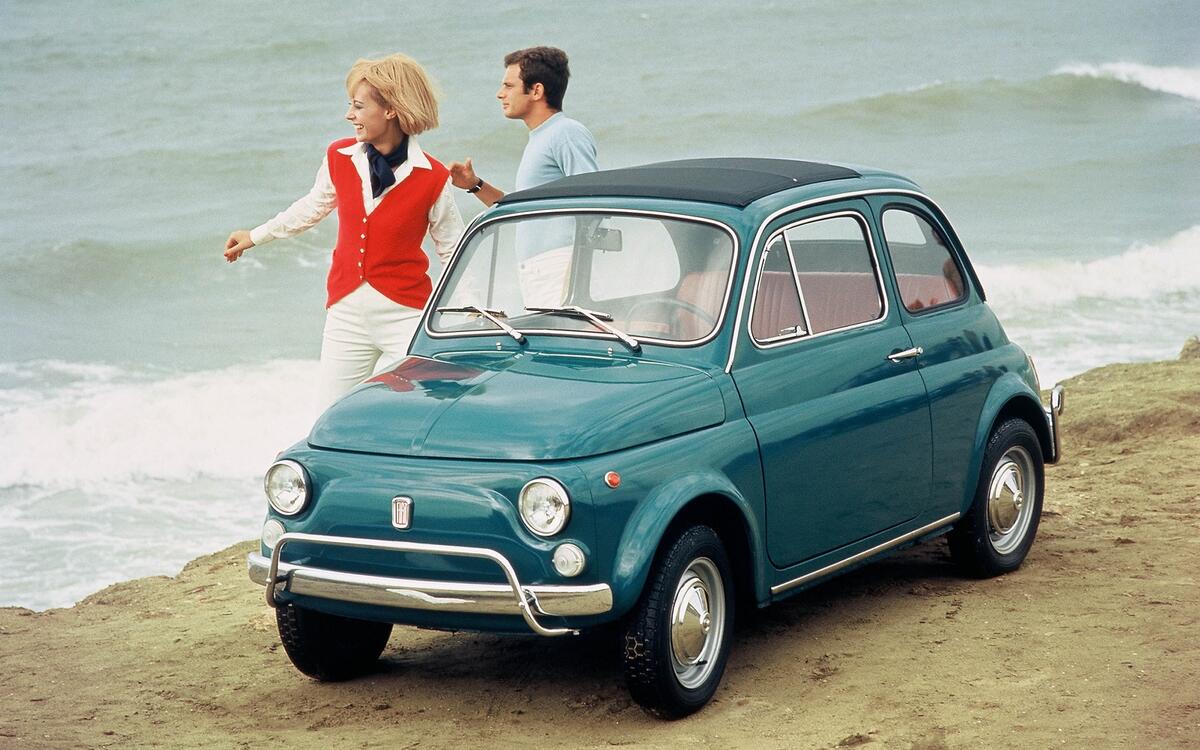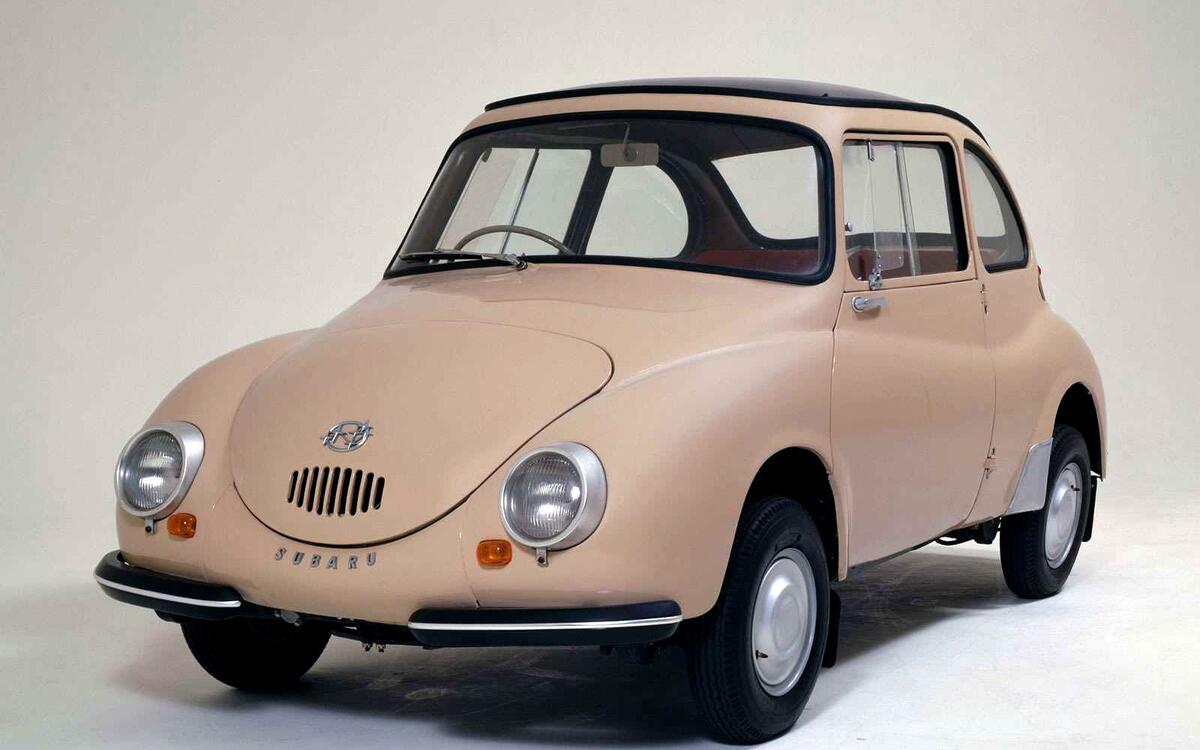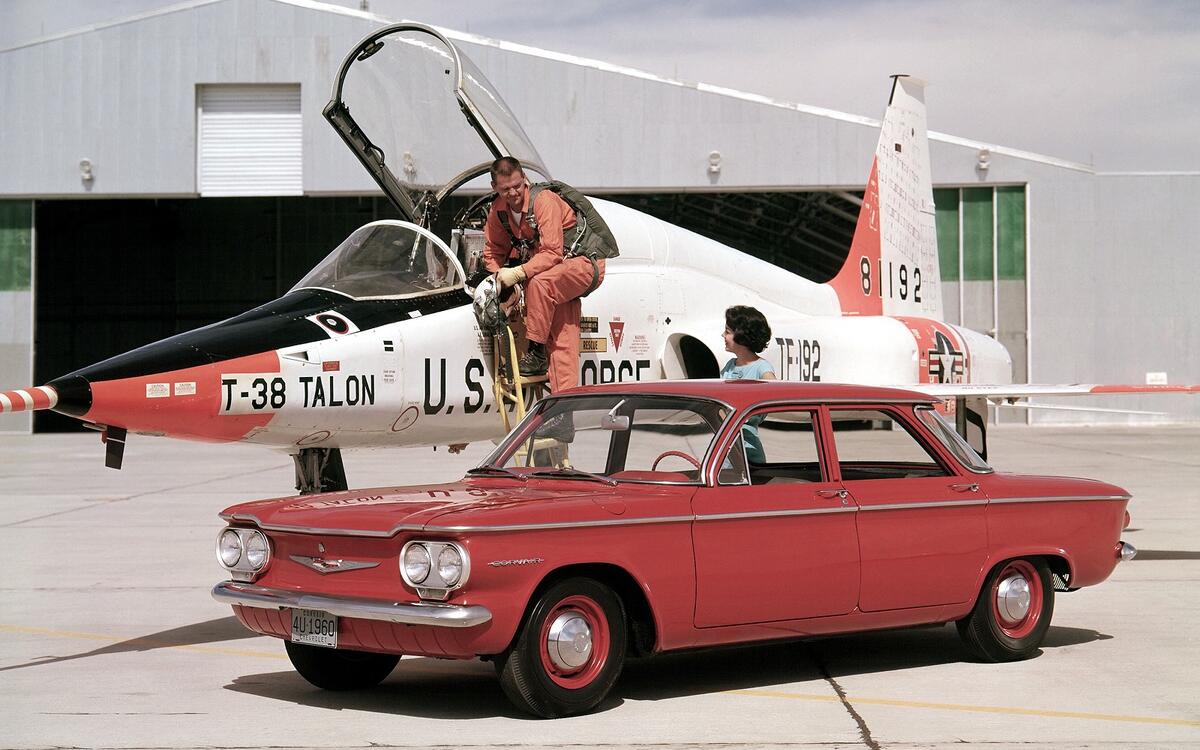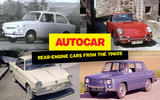 Slide of
Slide of
An entire generation of motorists learned to drive on a rear-engined car.
Rear-engined layouts became immensely popular during the 1950s and the 1960s and companies from all over the automotive spectrum touted their merits in every market they sold cars in.
Moving the engine to the back reduced the cost of a car and made its interior more spacious while keeping its overall dimensions in check, they argued.
Granted, it occasionally required the use of sandbags to keep the front end pointed in the right direction.
Most car companies moved away from the rear-engined layout as quickly as they adopted it. Here we look back at its best days.
 Slide of
Slide of
Why rear-engined?
Weight, cost and packaging constraints drove several automakers towards the rear-engined layout after World War II.
In his book, Fiat engineer Dante Giacosa explained why the Italian firm adopted the configuration for the 600.
“The decisive element deciding me in favor of the rear engine-transmission arrangement was cost.
The front arrangement was attractive because of the technical advantages presented by front-wheel drive, and even more because of the space it would leave free for the coachwork, but it would have made an economy model of the size we aimed at much more expensive than the rear-engined arrangement.”
Though he speaks only on behalf of Fiat, his reasoning explains why most mainstream auto-makers adopted a rear-engined layout. The configuration began rising in popularity well before the 600 made its debut, though.
 Slide of
Slide of
Tatra V570 (1931)
Tatra started experimenting with rear-engined cars when it built a prototype named V570 in 1931.
Its creators argued putting the engine in the back made the car quieter and more spacious because it didn’t need a transmission tunnel.
The layout also let them design a more aerodynamic body by extending the back end.
The V570 was never mass produced but it’s a fascinating part of history because many historians claim it directly influenced the Volkswagen Beetle without Tatra’s consent.
 Slide of
Slide of
Tatra 77 (1934)
Tatra channeled the lessons it learned from the V570 project into a production car named 77.
Presented in 1934, it was much bigger than the prototype that helped shape it but the two cars shared several important attributes like a streamlined design and a rear-mounted engine.
The unit in question was an air-cooled V8 rated at 60hp. The later 77a received a bigger, 75hp V8.
The 77 can hardly be considered a mass-produced car. Production ended in 1938 after Tatra made about 250 examples.
It's significant because it laid the foundations Tatra built on until it stopped making passenger cars in 1999.
The 700, its last car, was a big, aerodynamic four-door with a rear-mounted, air-cooled V8 – just like the 77.
 Slide of
Slide of
Volkswagen Beetle (1938)
Germany’s Nazi government asked engineer Ferdinand Porsche to develop an affordable, economical car capable of putting the country on wheels.
While Porsche started from scratch, he already had a very concise idea of the type of car he wanted to create. He had toyed around with the idea of a so-called people’s car for years and many of his designs used a rear-mounted engine.
The first pre-production Beetle prototypes were built in 1938. Sales grew slowly in the aftermath of World War II but they sky-rocketed during the 1950s.
The millionth Beetle was made in 1955; the two millionth example was made in 1957. The Beetle outgrew its status as a bare-bones economy car and became an icon.
It also gave its underpinnings to a wide variety of Volkswagen models and inspired dozens of models made by rival brands.
With over 21 million examples built during a 65-year long production run, the Beetle inarguably remains the most popular rear-engined car ever.
 Slide of
Slide of
Renault 4CV (1947)
Renault engineers secretly began working on the 4CV during World War II.
Company founder Louis Renault allegedly didn’t know about the model; no one told him because everyone knew he didn’t like the idea of a people’s car.
Some historians believe the 4CV’s creators chose a rear-engined layout after examining the Volkswagen Beetle but Renault claims it selected the configuration for cost and weight reasons.
4CV production began in 1947 and the model quickly traveled around the globe.
It was sold in the United States, manufactured under license in Japan by Hino (which later made the rear-engined Contessa) and built from complete knock-down kits in Sydney Australia.
Significantly, the 4CV gave its platform to the Alpine A106, the firm’s first car.
Renault made over one million examples of the 4CV until 1961. Its replacement, the 4, shifted to a front-mounted engine and front-wheel drive in the name of practicality.
 Slide of
Slide of
Porsche 356 (1948)
The first Porsche 356 prototype made in 1948 used a mid-mounted engine.
This configuration could have completely changed the course of Porsche’s history if it had stuck to it but the company chose to move the engine behind the rear axle on the production model for cost and packaging reasons.
The 356 became the first in a long line of rear-engined Porsche models that continues with the 911 in 2019.
Porsche never forgot about its origins and it has released several mid-engined cars since its inception, including the 914 and the 718 Boxster.
 Slide of
Slide of
Fiat 600 (1955)
The 600 sparked Fiat’s decades-long association with the rear-mounted engine.
The company’s top management envisioned it as a model that would put Italy on wheels after World War II.
It had to be cheap to buy, cheap to operate and cheap to service. Fiat seriously considered front-wheel drive but, as engineer Dante Giacosa explained, ultimately chose to make it rear-wheel drive and rear-engined to keep costs in check.
Early examples came with suicide doors and a water-cooled, 633cc four-cylinder engine. The four’s displacement grew during the car’s long production run.
The 600 spawned several models during its long production run. It became the SEAT 800 on the Spanish market, where it gained a second set of doors; Fiat never offered it as a four-door.
Neckar and Zastava made the car in Germany and in Yugoslavia, respectively. Factories in Argentina, Uruguay and Chile also built 600s with modifications made to suit local buyers.
And, in Italy, dozens of coachbuilders alchemized the 600 into coupes, convertibles, sports cars and even luxury cars.
Italian production of the 600 ended in 1969 but it remained available in Yugoslavia until 1985.
 Slide of
Slide of
Fiat 600 Multipla (1956)
Fiat wasted no time in expanding the 600 line-up. It released the 600 Multipla, a precursor to the modern minivan, in early 1956.
Engineers retained the rear-mounted engine but shifted the front seats to the space right over the front axle in order to carve out a roomier cabin without making the car significantly longer.
Hailed as one of the first leisure-oriented cars, the 600 Multipla could seat six, sleep two or carry a generous amount of cargo. Fiat replaced it with the more van-like 650T.
 Slide of
Slide of
Renault Dauphine (1956)
The Renault 4CV was France’s best-selling car between 1949 and 1955.
In an effort to keep the momentum going, the French firm created a bigger, more upmarket car that could lure 4CV owners who were ready for an upgrade.
The Dauphine was born in 1956 and it led the sales charts between 1957 and 1961; Renault’s bet had paid off.
It looked considerably more modern than the 4CV but the two models shared a number of mechanical components, including their rear-mounted, water-cooled four-cylinder engine.
Renault made several variants of the Dauphine. The portfolio included a more upmarket model named Ondine, high-performance Gordini- and 1093-badged models plus a convertible named Floride.
Alfa Romeo notably made the Dauphine for the Italian market; it was the firm’s only volume-produced rear-engined car.
Dauphine production ended in 1967 in France and in 1970 in Argentina. Renault made over two million examples.
 Slide of
Slide of
Fiat 500 (1957)
Fiat’s 600 exceeded all expectations but it remained out of reach for many buyers who settled for a scooter or a moped.
Decision-makers put Dante Giacosa in charge of creating a smaller, entry-level model capable of putting even the most modest households on wheels. The 500 made its debut in 1957.
Slow, noisy and unspeakably basic, the original 500 raised more than a few eyebrows when it went on sale.
Many argued buyers were better off saving up for a 600. Demand picked up after Fiat added features and bumped the 479cc, two-cylinder engine’s output to 15hp in late 1957.
The 500 remained a strong seller until production ended in 1975, three years after its intended replacement, the 126, went on sale.
Like the 600, the 500 spawned many variants inside and outside of Italy.
Abarth and Giannini famously took it racing, Fiat launched a more spacious variant named Giardinetta (which was also sold as an Autobianchi) and a beach-friendly model called Jolly traveled the world’s beaches.
Austrian company Steyr-Puch prepared the 500 for the Alps by fitting it with a more powerful flat-twin engine.
 Slide of
Slide of
NSU Prinz (1958)
In the 1950s, NSU was better versed in making scooters and mopeds than cars.
It began planning its return to the automotive space when it grew tired of losing clients who were seeking to upgrade to a four-wheeler with a fixed roof.
The Prinz nearly arrived with three wheels, like the Messerschmitt KR 200, but it made its debut at the 1957 Frankfurt auto show with four wheels and a rear-mounted, two-cylinder engine.
Production began the following year with a 20hp, 600cc air-cooled twin.
The Prinz kept its rear-engined configuration as it received upgrades including a complete redesign in 1961 and several high-performance, Gordini-bashing variants during the 1960s.
 Slide of
Slide of
Subaru 360 (1958)
An eccentric Japanese law convinced Subaru engineers to place the 360’s two-stroke, two-cylinder engine in the back.
Early on, they knew the model needed to comply with the strict kei car regulations announced in 1949 to convince motorists to think small.
This meant it couldn’t stretch longer than 118in, wider than 51in tall and taller than 78in.
Placing the engine in the back cleared up enough space for four adults in the passenger compartment while staying under the size limits imposed by the Japanese government.
The 360 remained in production until 1971.
 Slide of
Slide of
BMW 700 (1959)
Like the tiny Isetta, the Michelotti-designed 700 played a significant role in saving BMW from collapse.
It took the company into a booming segment of the market it wasn’t present in.
BMW didn’t want to spend money on designing an engine from scratch so it modified the R67 motorcycle’s air-cooled, flat-twin for automotive use.
The firm mounted the engine behind the passenger compartment to better compete against the most popular cars sold in Europe during the late 1950s.
Production lasted between 1959 and 1965, a point by which BMW had already started forging its image as the purveyor of the ultimate driving machine.
Note: BMW 700 Coupe pictured.
 Slide of
Slide of
Chevrolet Corvair (1959)
Chevrolet released the Corvair for the 1960 model year in a bid to compete directly against the Volkswagen Beetle.
The Corvair used a rear-mounted, air-cooled engine but the similarities between it and its German rival largely ended there.
It wore a considerably more modern design, it was bigger and it offered buyers a flat-six engine that made 80hp in its initial state of tune. Sporty variants – including a turbocharged, 180hp model – joined the line-up in the early 1960s.
Chevrolet’s answer to European economy cars could have spawned an entire segment but its handling drew the damning criticism of safety advocate Ralph Nader.
His book Unsafe at Any Speed cemented the model’s reputation as a death trap. Chevrolet corrected most of the Corvair’s handling faults with a thorough update in 1965 but the damage was already done and the nameplate never recovered from it.
The firm didn’t dare release another rear-engined car after Corvair production ended in 1969.
 Slide of
Slide of
ZAZ Zaporozhets (1960)
The USSR-built ZAZ-965 launched the long-running Zaporozhets series in 1960.
It looked like a Soviet interpretation of the Fiat 600 and the resemblance wasn’t a pure coincidence. The Russian government instructed ZAZ engineers to closely examine the then-new Fiat before starting the design process.
The 965 wasn’t a carbon copy of the 600, however. It featured a torsion bar suspension system inspired by the one fitted to the Volkswagen Beetle and it came with an air-cooled V4 engine.
The 965 was replaced by the 966 – which openly drew inspiration from the NSU Prinz – in 1966 but it remained available until 1969.
The 966 morphed into the 968 in 1971 and remained available in various forms until 1994, always with a rear-mounted, air-cooled V4 engine.
 Slide of
Slide of
Simca 1000 (1961)
Simca tried every nearly mechanical configuration available. It experimented with rear-engined, rear-wheel drive models when it released the 1000 in 1961.
The four-door was designed with input from Fiat – which owned part of Simca – and it anticipated a rising demand for a bigger, more powerful car than the 600 powered by a 1000cc engine.
The team in charge of the 1000 set out to develop a humble family car priced within most people’s reach; they unintentionally created one of the most popular (and successful) race cars of all time.
The Rallye-badged variants of the Simca 1000 won competitions all over Europe and they remain popular as historic racers in 2019.
Abarth also tuned the model shortly after its introduction and Simca turned its entry-level family car into a pair of low-slung coupes called 1000 Coupe and 1200S, respectively.
Simca released the 1100 in 1967 with a transversally-mounted four-cylinder engine that spun the front wheels. It was sold alongside the 1000 until troubled Simca ended production of both models in 1978.
 Slide of
Slide of
Alpine A110 (1962)
The A106, Alpine’s first model, was rear-engined because it shared many mechanical components with the Renault 4CV.
The company stuck to this configuration when it designed the A108 and it found no reason to move the engine when it began working on the A110.
Compact, light and powerful, the A110 became one of the most successful rear-engined race cars ever to line up on a starting grid.
The A110 used Renault-sourced engines throughout its entire career. Early models came with 55hp, 956cc four-cylinder borrowed from the then-new 8 while later examples received a fuel-injected, 1605cc four-cylinder borrowed from the 17 TS and tuned to deliver 140hp.
Alpine, like Porsche, kept the rear-mounted engine for as long as possible. The A310 and the A610 were both rear-engined. The born-again A110 released in 2017 switched to a mid-engined layout, however.
 Slide of
Slide of
Renault 8 (1962)
Many understandably assumed Renault would stop making rear-engined cars when it released the front-wheel drive 4 in 1961.
The company wasn’t quite done, however. The Dauphine was beginning to show its age and Renault sought to replace it with a new model named 8.
Its boxy design broke away from the Dauphine’s soft, rounded lines but the two cars were similar under the sheet metal.
Renault kept the water-cooled, rear-mounted engine instead of making the 8 front-engined and front-wheel drive like the 4. It likely worried about alienating a client base who had driven rear-engined cars since the 1940s.
Renault filled the gap between the 8 and the 16 by releasing another rear-engined model named 10.
It was an evolution of the 8 with a longer front end that wore a model-specific design and a nicer interior.
The best-remembered variant of the 8 is the Gordini, which arrived in 1964 with a 90hp, 1108cc engine. It gained a 100hp, 1255cc four-cylinder (and two additional lights up front) in 1967.
French production of the 8 stopped in 1973, six years after Renault made the last Dauphine, but the model survived until 1976 in Spain.
 Slide of
Slide of
Hillman Imp (1963)
Hillman released the rear-engined Imp in 1963. Designed to tackle the Mini head-on, the Scotland-built Imp had a clever feature none of its competitors could boast about.
Its rear window opened upwards to let motorists place luggage on the back seat. Those who needed more space could fold the rear seatback flat, another unusual feature during the 1960s.
Hillman went to great lengths to make the Imp easier to live with on a daily basis than the Mini but reliability problems (notably with the cooling system) gave it a bad reputation it couldn’t recover from.
Strikes at the Linwood factory that built it compounded its problems. The Imp’s less-than-illustrious career contributed greatly to the financial problems of Hillman parent company Rootes and pushed it into Chrysler’s arms during the 1960s.
 Slide of
Slide of
Porsche 911 (1963)
Porsche replaced the 356 with the 901 in 1963. It was a brand-new model from the ground up; it wore a sleeker design and it received a flat-six engine.
Peugeot swiftly reminded Porsche that it owned every three-digit nameplate with a zero in the middle so the 901 became the 911 shortly after its introduction. The rest, as they say, is history. The 911 is one of the most famous rear-engined cars ever made.
The 911 has gone through many, many evolutions in its 56-year history. It has gotten bigger, heavier, more advanced and jaw-droppingly powerful.
It shifted from air-cooling to water-cooling and it may even go hybrid in the early 2020s. It has always remained rear-engined and this configuration continues to shape its emblematic design.
 Slide of
Slide of
Fiat 850 (1964)
Developed to take the torch from the 600, the Fiat 850 was a new design built around the same rear-engined layout as its predecessor.
Released in 1964, the 850 should have arrived with a sloping silhouette like the 600’s but internal testing revealed prototypes weren’t aerodynamically efficient.
They had nearly the same 68mph top speed as the 600 even though their horsepower output had jumped from 29 to 40.
Fiat rushed a three-box design to production to avoid delaying the car, according to Dante Giacosa, and the 850 went on sale right on schedule with a 75mph top speed.
SEAT again built the 850 under license and it again released a variant with an extra set of doors.
Back in Turin, Fiat had watched coachbuilders steal the spotlight with sporty variants of the 600 and it was determined not to make the same mistake twice.
It released coupe and convertible variants of the model in 1965 and fitted both with a more powerful version of the 843cc engine.
Coupe and Spider models received a 903cc four-cylinder engine in 1968. In the United States, Fiat moved in the opposite direction.
For years, it sold the 850 with an 817cc four to skirt emissions regulations. Production ended in 1973 and Fiat replaced the 850 with the front-engined, front-wheel drive 127.
 Slide of
Slide of
Škoda 1000 MB (1964)
Škoda didn’t ask its research and development department to make the 1000 MB rear-engined.
The car simply had to be lighter, more efficient and more compact than the firm’s other models. In the late 1950s, that meant ditching body-on-frame construction.
With that matter settled, engineers considered three options: front-engined and front-wheel drive, front-engined and rear-wheel drive as well as rear-engined and rear-wheel drive.
They chose the latter because it made the car simpler to build – and consequently cheaper to sell.
The 1000 MB was the first in a decades-long series of rear-engined Škoda models that ended when the last 120 rolled off the assembly line in 1990.
The model family included four-door passenger cars, two-door coupes with a fastback-like roof line and a rally-winning, hot-rodded model named 130 RS.
 Slide of
Slide of
Fiat 126 (1972)
The popularity of rear-engined cars had already started to wane when Fiat released the 126 in 1972.
Developed to finally replace the 500, it stood out with a boxier design that brought it in line with the prevalent styling trends of the 1970s.
The sheet metal hid a packaging solution largely borrowed from the 500, however. Power came from an air-cooled, two-cylinder engine mounted behind the passenger compartment.
In early cars, the 594cc twin sent 23hp to the rear wheels through a four-speed manual transmission.
The 126 withered on the vine for even longer than the 500. In 1987, its 15th year on the market, it received a water-cooled, 704cc two-cylinder and a rear hatch for added practicality.
Fiat stopped selling the 126 in many western European countries in 1993 but the model remained hugely popular in Poland.
Polish production began in 1973 and didn’t stop until 2000. All told, 4.6 million examples of the 126 were manufactured. To add context, Fiat made 3.8 million 500s.
 Slide of
Slide of
Leaving the rear-mounted engine behind (late 1960s)
The original Mini defiantly proved it was possible to package a front-wheel drive powertrain in a small, economy-oriented car.
It led many automakers to seriously search for alternatives to the rear-mounted engine during the 1960s.
Those who had never released a rear-engined model, like Citroën and Saab, sat back and watched.
Renault cut its teeth with the 1959 Estafette and truly started its shift when it released the 3 and the 4 in 1961. Fiat’s Giacosa had started looking into front-wheel drive in 1947 and he finally brought the layout to production in the 1964 Autobianchi Primula. Simca introduced the 1100 in 1967, and Fiat unveiled the 128 two years later. 1969 is also when Chevrolet stopped building the Corvair and never, ever considered making another rear-engined car.
Even Volkswagen, a company many believed would never change, warmed up to the idea of making front-engined cars. Its first was the K70, which unexpectedly joined the Volkswagen line-up from NSU in 1970. The Passat introduced in 1973 and the Golf launched in 1974 both used a similar layout.
Note: US-spec Volkswagen Rabbit pictured.
Millions of rear-engined cars roamed the globe in the 1960s
Advertisement



